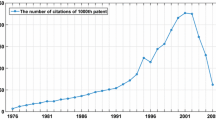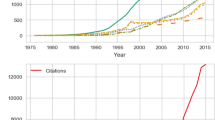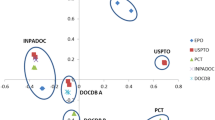Abstract
While there is a large body of research analyzing the overall structure of citation relations for patents, there has been very little research seeking to clarify the characteristics of fields relating to the diffusion of technology through observing the citation network surrounding each patent individually and tracing its growth. This study focused on the classifications assigned to patents and examined the diversity of the fields of patents citing each patent from the following two perspectives: (1) expected values for growth in the number of citing fields, when regarding the observation period as being in a synchronic state and assuming that the strength of connections between each patent and citing fields is constant; and (2) empirical values for growth in the number of citing fields according to the increase in the cumulative number of citations over time. From the results, it was confirmed that the strength of potential connections between each patent and citing fields changes over time. Especially in the fields of “chemistry; metallurgy” and “physics,” the following change is considerable: a patent tends to receive citations repeatedly from a limited range of fields for a while, but later comes to be cited by various fields.











Similar content being viewed by others
References
Atkinson, A. B. (1970). On the measure of inequality. Journal of Economic Theory, 2(3), 244–263.
Baayen, R. H. (2001). Word frequency distributions (text, speech, and language technology). Dordrecht: Kluwer Academic.
Efron, B., & Thisted, R. (1976). Estimating the number of unseen species: How many words did Shakespeare know? Biometrika, 63(3), 435–447.
Fujii, A., Utiyama, M., Yamamoto, M., Utsuro, T., Ehara, T., Echizen-ya, H. & Shimohata, S. (2010). Overview of the patent translation task at the NTCIR-8 workshop. In Proceedings of NTCIR-8 workshop meeting, (pp. 371–376). Tokyo: National Institute of Informatics.
Gini, C. (1936). On the measure of concentration with special reference to income and wealth. In Abstracts of papers presented at the research conference on economics and statistics held by the Cowles commission for research in economics (Colorado College Publication, general series 208; study series 21) (pp. 73–80). Colorado: Colorado College.
Good, I. J., & Toulmin, G. H. (1956). The number of new species, and the increase in population coverage, when a sample is increased. Biometrika, 43(1), 45–63.
Haruna, S., Jinji, N., & Zhang, X. (2010). Patent citations, technology diffusion, and international trade: Evidence from Asian countries. Journal of Economics and Finance, 34(4), 365–390.
Herfindahl, O. C. (1950). Concentration in the steel industry, PhD thesis. New York: Columbia University.
Horvath, J. (1970). Suggestion for a comprehensive measure of concentration. The Southern Economic Journal, 36(4), 446–452.
Jang, S.-L., Lo, S., & Chang, W. H. (2009). How do latecomers catch up with forerunners?: Analysis of patents and patent citations in the field of flat panel display technologies. Scientometrics, 79(3), 563–591.
Lee, Y.-G. (2009). What affects a patent’s value? An analysis of variables that affect technological, direct economic, and indirect economic value: An exploratory conceptual approach. Scientometrics, 79(3), 623–633.
Li, X., Chen, H., Huang, Z., & Roco, M. C. (2007). Patent citation network in nanotechnology (1976–2004). Journal of Nanoparticle Research, 9(3), 337–352.
Li-Ying, J., Wang, Y., Salomo, S., & Vanhaverbeke, W. (2013). Have Chinese firms learned from their prior technology in-licensing?: An analysis based on patent citations. Scientometrics, 95(1), 183–195.
Meyer, M. (2000). What is special about patent citations?: Differences between scientific and patent citations. Scientometrics, 49(1), 93–123.
Nanba, H., Fujii, A., Iwayama, M., & Hashimoto, T. (2008). Overview of the patent mining task at the NTCIR-7 workshop. In Proceedings of NTCIR-7 workshop meeting (pp. 325–332). Tokyo: National Institute of Informatics.
Pratt, A. D. (1977). A measure of class concentration in bibliometrics. Journal of the American Society for Information Science, 28(5), 285–292.
Ray, J. L., & Singer, J. D. (1973). Measuring the concentration of power in the international system. Sociological Methods & Research, 1(4), 403–437.
Sato, Y., & Iwayama, M. (2006). A study of patent document score based on citation analysis. Information Processing Society of Japan SIG Technical Report, 2006(59), 9–16.
Tamada, S. (2010). Industry-university cooperative innovation. Nishinomiya: Kwansei Gakuin University Press.
Theil, H. (1967). Economic and information theory. Amsterdam: North-Holland Publishing Company.
Tweedie, F. J., & Baayen, R. H. (1998). How variable may a constant be?: Measures of lexical richness in perspective. Computers and the Humanities, 32(5), 323–352.
Wasserman, S., & Faust, K. (1994). Social network analysis. New York: Cambridge University Press.
WIPO (World Intellectual Property Organization). (2010). International Patent Classification (IPC). http://www.wipo.int/classifications/ipc/en/. Retrieved May 2, 2013.
Yoshikane, F. (2000). Concentration in bibliometric distributions: The notion of concentration and concentration measures. Journal of Japan Society of Library and Information Science, 46(1), 18–32.
Yoshikane, F. (2013). Multiple regression analysis of a patent’s citation frequency and quantitative characteristics: The case of Japanese patents. Scientometrics, 96(1), 365–379.
Yoshikane, F., & Kageura, K. (2004). Comparative analysis of coauthorship networks of different domains: The growth and change of networks. Scientometrics, 60(3), 433–444.
Yoshikane, F., Kageura, K., & Tsuji, K. (2003). A method for the comparative analysis of concentration of author productivity, giving consideration to the effect of sample size dependency of statistical measures. Journal of the American Society for Information Science and Technology, 54(6), 521–528.
Yoshikane, F., Suzuki, Y., & Tsuji, K. (2012). Analysis of the relationship between citation frequency of patents and diversity of their backward citations for Japanese patents. Scientometrics, 92(3), 721–733.
Acknowledgments
This work was partially supported by Grant-in-Aid for Scientific Research (C) 23500294 (2013) from the Ministry of Education, Culture, Sports, Science and Technology, Japan, and we would like to show our gratitude to the support. We also acknowledge the anonymous reviewers for their helpful comments.
Author information
Authors and Affiliations
Corresponding author
Rights and permissions
About this article
Cite this article
Yoshikane, F., Suzuki, T. Diversity of fields in patent citations: synchronic and diachronic changes. Scientometrics 98, 1879–1897 (2014). https://doi.org/10.1007/s11192-013-1165-7
Received:
Published:
Issue Date:
DOI: https://doi.org/10.1007/s11192-013-1165-7




